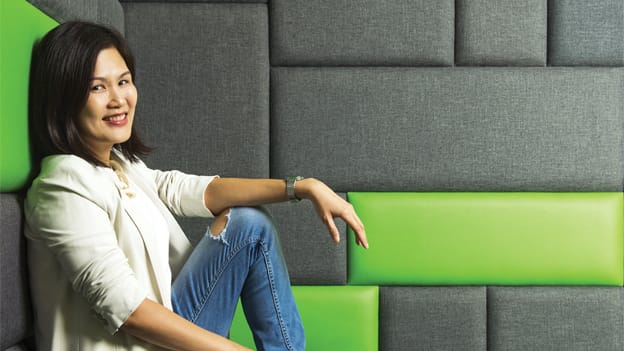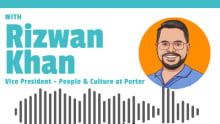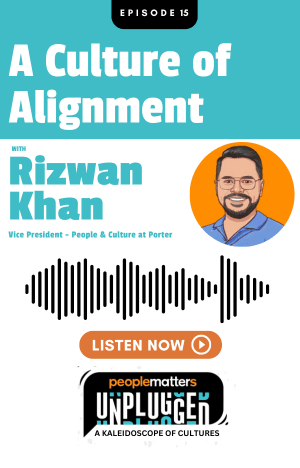We want to make people micro- entrepreneurs: Grab's Chin Yin Ong

Following its acquisition of rival ride-hailing app Uber, Grab has become one of the leading online-to-offline mobile platforms in Southeast Asia and uses data and technology to improve everything from transportation to payments across a region of more than 620 million people. With eight investment rounds, Grab has diversified into services for private cars, motorcycle taxis, carpooling as well as goods and food delivery while investing in mobile-software research and development.
But while scaling-up, practices related to culture, performance, and sustainability become all the more decisive.
In this interview with People Matters, Chin Yin Ong, Head of People at Grab shares Grab’s mission to work with governments, drivers, passengers, and the community, to unlock the true potential of the region by solving problems that hinder progress.
Where is Grab today in terms of business after the acquisition of Uber? What are you now focusing on?
At this point in time, the ultimate ask from all of us is to focus on the right things for everyone involved. What has not changed is that at the heart of this all is our focus on the Customer. Our customer segment is a bit wider than what people imagine it to be. They are not just the passengers who take our cabs. Our business is across transport to food to payments and much more. And by implication, our customer base includes our passengers, our drivers our agent network (it is a network of micro-entrepreneurs) and anyone who aspires to be a micro-entrepreneur within South East Asia. We want to drive South Asia forward through focusing on the needs of the population within this region and we are actively looking at providing a suite of services to consumers that make their lives better while giving people a chance to be micro-entrepreneurs, thus making the unbanked/invisible, visible. This is our purpose and it is very important to us. With the acquisition of Uber, this has been made stronger because there are many people in Uber who have the same purpose in life, who identify with the same mission.
How has your mandate as the Head of People changed since you joined Grab? What is your mandate for this year?
When I joined Grab, we were a different company with a different level of funding. The HR team at that time did its best with the environment it was operating in. When I got on board, we were in the middle of closing a huge round investment and it was the biggest funding we had received at that point of time. One of the first things we looked at is to find the right “carbon-fiber” structure to put in place for the organization — to create a light yet strong processes and systems for Grabbers. The way we approach this was to “Design for Grab” for which we left the best practices of the industry and focused on designing and customizing practices for Grab and according to its needs. We probably spent a good one year on doing this. And considering we were expanding very quickly as an organization, the second thing was to focus on building a “recruitment machine” that helped with the growing headcount but not at the expense of quality.
Another important aspect is from the cultural point of view; we needed to evolve. The company is changing and is really different from when it started. So, how to re-evolve and ensure that culture is always right for Grab. Finally, to make sure that we continuously improve and give a positive and personalized experience to our customers and employees alike.
When you say that you wanted to “design for grab” and not copy what someone else was doing, how are you going about that considering the three priorities you mentioned?
Let me give you an example that will sum up what I am trying to say. When we looked at the performance management system, the ‘in-thing’ that all other organizations were doing was not to have performance ratings at all and remove the bell curve. But we went back to see the issues at Grab. Because Grab grew so fast, it didn't have a common language nor understand the concept of a ‘great performance’. This is why I introduced ratings. It was not to force people under a certain curve but make sure that as a company we know and set the standards of what ‘performance’ is. The way we calibrate is different from many companies. We are much more rubric-based rather than percentage-based and we don't look at curves. We talk about people, what they have done, and if ‘what they have done’ fits into our definition of meeting both the performance and culture bar at Grab. To elaborate, Grab is a place where ‘what you do’ and ‘how you do it’ are equally important. Thus, the weightage of performance and culture is literally 50-50. We not only look at the amazing metrics a person has delivered, but we also talk a lot about the feedback that a person receives from the team, how that person collaborates with and also develops other people around him/ her. These are what we discuss during our calibration sessions. Although it sounds simple, it is not really. Having one-on-ones and preparing managers how to have more developmental conversations is a big task. Manners and habits in which such conversations happen to take time. Sometimes you have to be the nagging mother and encourage people to do more.
If you look at performance management at Grab, what is that one thing that you need to fix or something that still needs to be addressed?
I feel that people are changing their expectations about performance management. It is increasingly about measuring performance based on the individual’s own performance as opposed to comparing the individual against their peers. It is about what you can do and what you need to develop, and if you are reaching your potential fast enough. I believe that every single one of us has areas and opportunities to develop in and that needs to be crafted for you and not against others. That is something we focus on cracking and re-calibrating whether it is ratings or 360-degree feedback etc. So, we are on a journey and hopefully, in 2019 we will have the version 2 of what performance management is.
What are the things that you are changing from a talent management perspective?
Well, this is something that we are debating on. Initially, there were thoughts about building big StrengthsFinder like what Facebook and Accenture use. But to really go with things like that, it takes a lot of investment – not so much money but effort. At this point in time, what we are doing is that we are instituting some fundamental programs rather than launching into StrengthsFinder.
When you talk about improving the effectiveness of sustainability, is it specific to an overall company or referring people as a function?
It is both. We are making sure that within our teams, we are continuously improving all our processes and holding what we call “Fixathons” to fix issues that we are seeing. On a wider level, I think, Grab is really growing up to be a sustainable company. The way business is scaling, we are looking at smart resource allocation. The great thing about Grab is that we spend time thinking about people resources, skills, and how we can map those skills with what we need in future, and identify the major blockers.
But you can’t use a broad stroke with a company like Grab. Every team has a slightly different headcount efficiency target based on what is right for the team. I want to stress on the fact that we are still on a journey and we are trying to find out what the right thing is. I think the thing to learn is that you just have to go in and learn the – work that the team does, about what they produce, and how to measure how effective they are in their production and then we keep improving it. We really partner with business to be able to do that.
You spoke about the people function and going deeper into each function to get into the details and make it perfect each one of them. What is the role that technology is playing?
If you ask me that if AI is going to take over humans, I would say not in the near future. I still believe that humans are amazing beings and, like in the example of the chess master against IBM’s AI machine, when humans work together with the machine the combination will beat the machine. It is about working together rather than the fear of technology taking over. The other thing is how you look at tech in helping you to achieve speed, scale, and personalization. Those are the 3 things that technology will be very good at doing.
What drives you? What keeps you going?
I have been blessed with people giving a chance when I did not have all the necessary qualifications and I feel extremely responsible towards them. I think that’s one of my drivers. Also, empathy drives me. When you go through hardships, it actually builds empathy and when you have empathy, you are able to understand and work with people much better. In my life, I have been blessed to be shown such grace and that has helped me show grace too.













